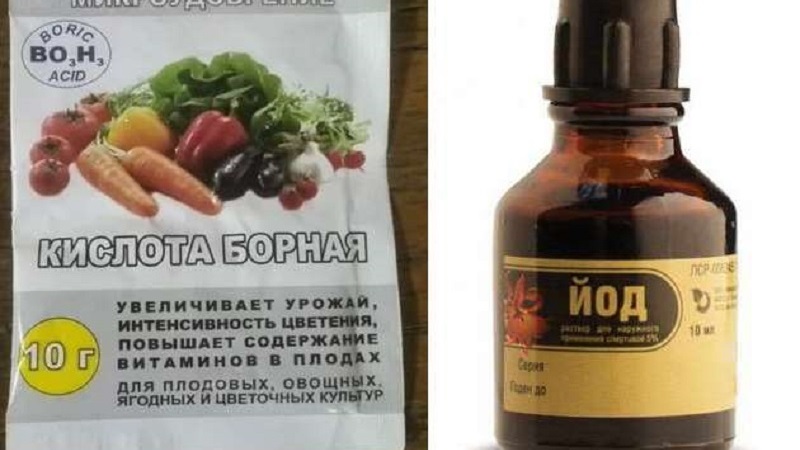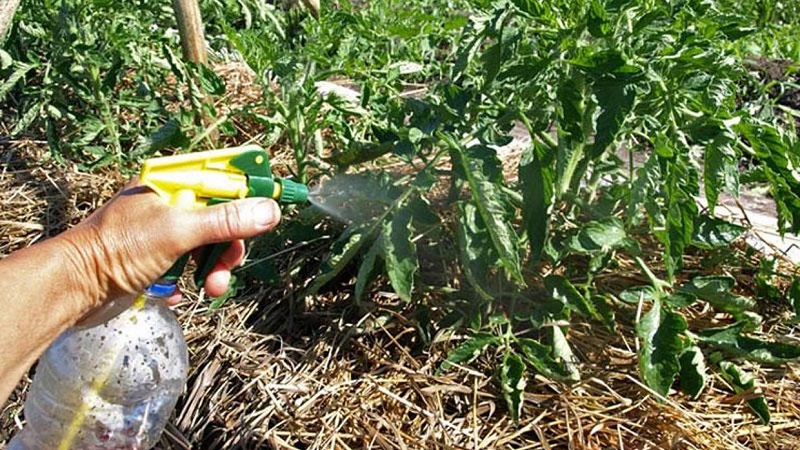Instructions for processing tomatoes from late blight with iodine and boric acid: we fight the disease quickly and effectively
Growing tomatoes is a laborious process that requires improving the nutrient composition of the soil. Poor plant care often leads to the appearance of fungal diseases. In the article we will tell you how to process tomatoes from late blight with iodine and boric acid.
The content of the article
The benefits of boric acid and iodine for tomatoes
Iodine and boric acid are not used in large quantities.
Enough small dose to tomatoes:
- strengthened the immune system;
- did not accumulate nitrates;
- formed more ovaries;
- resisted negative environmental influences;
- not attacked by bacteria and fungi;
- bore abundantly.
If you use such drugs incorrectly, you get the opposite result.... Often the plant turns yellow, sheds foliage, dies.

The principle of action of boric acid and iodine in the fight against late blight
Iodine and boric acid are harmless to vegetables... They qualitatively disinfect the soil and planting, prevent the development of late blight.
Gardeners recommend to use preparations in the form of top dressing in the soil... A diseased plant is transformed in 2-3 days, as the immune system is strengthened and flowering accelerates.
Reference. Experts continue to argue about the effectiveness of iodine and boric acid. They have been shown to help increase resistance tomatoes to late blight... But many gardeners insist on the destruction of infected plantings, considering this to be the only correct method in the fight against the fungus.
How to prepare a solution of iodine and boric acid
Preparation of the product implies compliance with the proportions... Often auxiliary components are added to the main components, for example, soda or ammonia.
Proportions and instructions
Required:
- 1 tsp 1% boric acid;
- 30 drops of iodine;
- 10 liters of water.
Components mix according to the following instructions:
- Dilute boric acid in warm water. A glass is used for these purposes.
- Add the resulting solution to 10 l of water.
- Cool the mixture so that it is cool.
- Iodine is added to the finished suspension.
Tomato processing begins with mid-season.
Reference.Gardeners recommend adding 100 g of garlic to the solution. The mixture is filtered before use.
Soda solution
In 10 liters of water, 5 tbsp is diluted. l. soda, pre-prepared boric mixture (1 tsp for 1 tbsp. warm water). Then add 30 drops of iodine and insist the solution for 2 hours.
The components will slow down the development of the funguswill help the fruit develop normally.
With added ammonia
This the solution will not only protect tomatoes from late blight, but also help fight pests... In 10 liters of water add 2 g of boric acid and ammonia, 2 tsp. iodine and 1 tbsp. ash.
Interesting on the site:
How to use phytophthora serum on tomatoes
How to process tomatoes
Plants are treated by applying solutions under the root or spraying... Be sure to follow the recommendations, take into account the frequency of treatment.

Processing instructions
The process technology is as follows:
- The plants are preliminarily examined for diseased processes. The affected areas are removed and burned.
- Water the plantings with clean water. Then add 0.5 l of solution under each root.
- The aerial part of the tomatoes is sprayed only in dry weather. If the bushes are in the greenhouse, after each procedure, they provide high-quality ventilation.
- Processing is carried out in the morning or evening. Otherwise, burns will appear on the leaves of the plant.
When treating tomatoes, be sure to process the potatoes that are nearby... Crops are prone to the same diseases.
Timing and frequency of procedures
For prevention, 3 routine tomato treatments are performed:
- before flowering, when the buds began to form;
- during flowering;
- at the beginning of fruiting.
If late blight has already been noticed, the bushes are sprayed every 10 days.... Severely affected tomatoes cannot be treated. They are disposed of away from plantings, and neighboring bushes are sprayed with a working solution.
At this stage, beginners make a lot of mistakes.... The most common:
- Watering plants at the peak of disease activity. This makes the situation worse as the fungus thrives in a humid environment.
- The use of chemicals in parallel with iodine and boric acid. Often, a combination of various agents leads to the death of tomatoes. After processing, they accumulate poisons, begin to turn yellow and rot.
- Boric acid in the form of a powder is not completely dissolved. The remaining granules in the mixture cause burns on the leaves.
Tips and tricks from experienced farmers
The following recommendations will help reduce the risk of the appearance and development of late blight:
- Compliance with the rules of crop rotation. It is not recommended to plant tomatoes after and near eggplants, potatoes, peppers. Re-planting of the culture at the same place occurs no earlier than after 4 years.
- Choosing a sunny site for planting tomatoes. Dark, poorly ventilated greenhouses or garden beds will become a source of fungal growth.
- Improving soil composition. If it contains a large amount of lime, peat is added to the hole, and sprinkled with sand on top. Another option is to pour onion peel into the hole.
- Compliance with the landing pattern. Plants located close together prevent the penetration of sunlight. This creates favorable conditions for the development of the fungus. The distance between the bushes is kept at 50 cm, between the rows - at 70 cm.
- Timely removal of overgrowth and unnecessary foliage. Very often, fungal spores appear on them.
- Compliance with the rules of feeding with nitrogen fertilizers. Components are introduced only in the first half of the growing season. Then they provoke the appearance of late blight.
- A solution of boric acid and iodine is prepared only outdoors in warm, calm weather. For spraying, the ready-made suspension is poured into a spray bottle and make sure that the agent falls on the plants in small drops. During the procedure, protective equipment is used.
Conclusion
Treating tomatoes with boric acid and iodine is a good way to prevent late blight and increase yields. But such drugs are not able to completely destroy the fungus, but are suitable as effective prevention.
It is better for beginners to learn only 2 rules: it is important to observe the proportions while preparing the solution and follow the processing instructions.